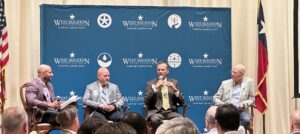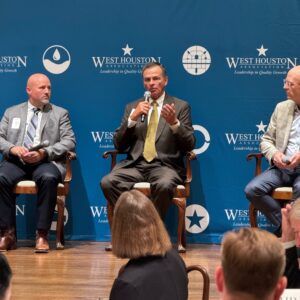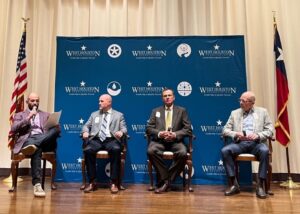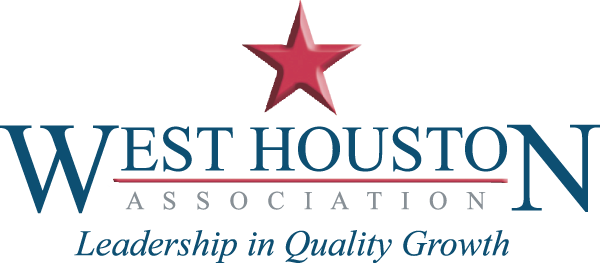
The expansion of toll roads and highways in Fort Bend County is driving development, improving connectivity, and boosting economic growth. Key projects like the Grand Parkway Segment C, Missouri City Park and Ride, widening of US-90 and IH-10, extension of the Westpark Toll Road to Fulshear, and future extensions of the Fort Bend Parkway Toll Road to SH-36 are significantly enhancing the region’s infrastructure. Additionally, the continued planning of Highway 36A ensures long-term growth opportunities. These investments are opening up new areas for housing and commercial development, strengthening connections to employment hubs, and fostering social integration by linking diverse communities. Ultimately, these efforts are contributing to the county’s prosperity and quality of life.
The WHA hosted forum, Connecting Communities: The Impact of Toll Road & TxDOT Expansions in Fort Bend, featured panelists David Gornet, Executive Director at FBCTRA, Grady Mapes, Transportation Engineer & Director at TxDOT, and Jay Sears, Owner of NewQuest Properties. The panel was moderated by Jim Webb, WHA Board Member and CEO at The Goodman Corporation.
Webb opened the discussion by highlighting the growth Fort Bend County has seen over the past two decades, and noted that the county is expected to double in population by 2050. When asked what’s driving growth, Sears said, “Great schools, great communities, and quality development.” Sears elaborated that retailors care about growth, what’s driving the growth, and the sustainability of that growth. Webb pointed out that, given that about 50% of the people who live in Fort Bend work in Houston, highlighting the important synergy between the communities. Sears spoke on the METRO Park & Ride that NewQuest is collaborating on with METRO Transit and Fort Bend Transit, and how an integrated park-and-ride allows residents to travel in and out of the city in an effective way.
The conversation turned to how projects are planned in Fort Bend, especially given the unprecedented growth over the past two decades and how TxDOT can stay ahead of the growth. “We take the time to do the studies and understand where the needs are. Development just happens so fast in some areas that we just aren’t able to stay ahead of that,” Mapes explained. However, TxDOT is consistently analyzing and anticipating the future needs of the region. Talking with developers on their plans and local governments having a major thoroughfare plan are important parts of the forward-thinking that can bring some of these future needs to light.

Speaking of forward planning, Gornet addressed the history of the Fort Bend Toll Road system saying that local leaders “have been working to be responsive; proactive rather than reactive; in creating the Toll Road Authority.” Moreover, it was forward thinking by the development community that led to a lot of push for the Grand Parkway. “The development community saw that demand was coming in the 1980s,” said Gornet, who also pointed out that it was a collaborative effort among the public and private sectors at the city, county and state levels. Fort Bend County and TxDOT are still working on who has primacy to build Grand Parkway Segment C. Regardless of primacy, it’s important that “all money earned on the Grand Parkway needs to stay within the project as a whole, for the benefit of the Grand Parkway as a system,” said Gornet. Expansion of the Fort Bend Toll Road to the south will also facilitate the movement of people who are living in upcoming developments, like Austin Point, get to the Medical Center or Downtown Houston.
The discussion then moved to other major projects. The widening of I-10 west of Katy was a result of the increased and further anticipated traffic, especially truck traffic, that was not planned for years ago. “Highway 90 and I-10 have seen a significant increase in warehouses and industrial buildings along this corridor which results in a significant increase in number of trucks on the road,” said Mapes. TxDOT is also planning to add managed lanes along what’s known as the ‘I-10 Inner Katy Corridor,’ which picks up at Voss and would then connect to I-45 as part of the North Houston Highway Improvement Project (NHHIP). “Ultimately,” Mapes goes on, “we are working to improve the managed lanes network.”
Webb then asked about TxDOT’s REAL Plan and how that connects with the managed lanes and other planned projects. The plan proposes a comprehensive mobility network connected to various hubs to mitigate the pressing challenges. Mapes explained that the team currently focused on freight movement along the Highway 90 & I-10 corridor, specifically targeting the area’s connectivity and mobility needs.
Thinking about comprehensive transit, the conversation turned to Transit Orientated Development. Sears discussed the history of NewQuest’s involvement with this type of project starting up in Cypress. For the first project Sears explained to make it feasible that, “It’s going to be a commercial development that happens to have a transit component, not a transit project with retail wrapped around it.” Moving to the Katy project, the transit was added to an already planned retail center. It works because it drops people at the retail. The newest project at Fort Bend Parkway at Highway 6 started with a Kroger project where “METRO riders would park at Kroger and the bus would pick them up… it filled up… it was time to build a garage.” The lesson learned from these projects was to apply commercial rules and human behavior to the process, putting the park & ride somewhere natural for people to go.
 Webb then turned the discussion to 36-A. Gornet discussed the need for the project ranging from moving freight from Port Freeport to moving people regionally, noting that “all the development has moved further west… they need mobility out there.” Grady discussed how how TxDOT is still actively studying the alignment for 36-A. The southern piece (SH 36 to I-10) is further along and there is still more work to be done on the northern piece (I-10 to 290). The estimated timeline for an alignment on the map is 2026.
Webb then turned the discussion to 36-A. Gornet discussed the need for the project ranging from moving freight from Port Freeport to moving people regionally, noting that “all the development has moved further west… they need mobility out there.” Grady discussed how how TxDOT is still actively studying the alignment for 36-A. The southern piece (SH 36 to I-10) is further along and there is still more work to be done on the northern piece (I-10 to 290). The estimated timeline for an alignment on the map is 2026.
Finally the conversation turned to funding. “We talked about toll facilities, we talked about p3 concepts, it seems innovate financing mechanisms and vehicles has been important in getting this stuff done,” noted Webb. While Fort Bend discussed a p3 route for the tollway, the focus has been focused on toll revenue and bonds to move the project forward. Sears mentioned that for several projects he is using partnerships with TIRZs, PIDs, and/or Chapter 380 agreements. “We’ve got a lot of different tools… These projects just cost a lot more, there is a lot more equity required, and we must get creative to hit the yield requirements that we need to hit,” said Sears. Meanwhile, TxDOT has been utilizing the Design Build delivery mechanism. Design Build allows for the most flexibility. “That’s why I [Grady] like to think about the contract as setting boundaries, and as long as we’re staying in the boundaries, there are many ways to get to the end result.”
Webb wrapped up mentioning that, “There’s a lot of space here, there is a lot to do, there is a lot of infrastructure that is needed… there is a lot of opportunity.” Sears chimed in that the demand for housing and the growth is a “great problem” that as a region we are fortunate to be dealing with this problem rather than being a region in decline. Gornet and Mapes both noted that growth is a challenge, not just roads but also drainage. As a concluding take away Webb’s reflection on growth is that “we need to do it responsibly and sustainably.”
Thank you to our sponsors for their support in making events like these possible!

